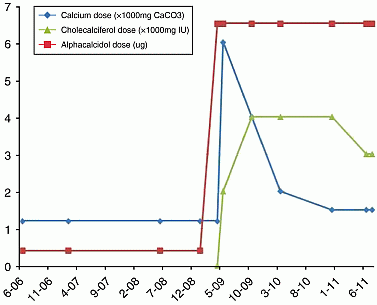ICEECE2012 Poster Presentations Clinical case reports - Thyroid/Others (81 abstracts)
Hungry bone syndrome in a patient with McCune–Albright syndrome after total thyroidectomy: case report
J. Kollerova , T. Koller , L. Kostalova & J. Payer
University Hospital Bratislava, Bratislava, Slovakia.
McCune–Albright syndrome (MAS) is a rare disease. It is characterized by a combination of polyostotic fibrous dysplasia, autonomous overproduction of hormones and skin hyperpigmentation.
Thirty-year-old patient with significant bone deformities and the history of multiple fractures of long bones despite treatment presented with multinodular goiter with long standing hyperthyroidism. During thyroidectomy in 2009 two enlarged nodules suspected for being inferior parathyroid adenomas were removed. In the postoperative period the patient developed severe symptoms of hypoparathyroidism: overt hypocalcaemia with tetany and the need for parenteral and then oral substitution of calcium and vitamin D. The doses required to achieve normal calcaemia are shown in Fig. 1. High bone turnover in fibrous bone dysplasia and removal of the functioning parathyroid glands were probably the causes of hungry bone syndrome described. We also assume hyperthyroidism as the aggravating factor. Primary hyperparathyroidism could also be one of the manifestations of autonomous endocrine overproduction in MAS but it was not confirmed in our case (biochemical parameters prior to operation, no parathyroid hyperplasia on histology). Two years postoperatively parathyroid hormone levels are within the normal range, but the doses of vitamin D and calcium supplementation remain unusually high, Fig. 1. Currently the patient has no symptoms and is surprisingly free of fractures since the operation with marked improvement in T-score.
In our report we describe a case of hungry bone syndrome with severe hypocalcaemia after accidental removal of two parathyroid glands during total thyroidectomy and subsequent need of unusually high doses of calcium and vitamin D substitution in a patient with McCune–Albright syndrome.

Figure 1 Doses of vitamin D and calcium.
Declaration of interest: The authors declare that there is no conflict of interest that could be perceived as prejudicing the impartiality of the research project.
Funding: This research did not receive any specific grant from any funding agency in the public, commercial or not-for-profit sector.




